Chile Nativo is one of the most respected tour operators in Patagonia and Torres del Paine. They offer unique accommodations for their trips at their Riverside Camp location inside the national park. It gives visitors a chance to sleep comfortably outdoors without having to truly rough it.
Since there isn’t a lot of detailed information on what it’s like to stay here, we’re doing a full deep dive by providing a Chile Nativo Riverside Camp review. We’ll cover everything from the lotus tents, bathrooms, meals, guides, and many other small details that you won’t find anywhere else.
Read more about Patagonia
- Ultimate Torres del Paine Travel Guide
- How to plan 10 days in Torres del Paine with this Patagonia itinerary
- The Ultimate Patagonia Packing List
- Reasons Why You Shouldn’t Do The W Trek
- Our Best Chile Travel Guide Content
How to get a deal in Torres del Paine?
- We are currently offering two different offers with the companies we personally worked with in Torres del Paine. With Chile Nativo, if you use Going Awesome Places as a referral, you’ll save 5% off of their available packages.
In This Article
- Chile Nativo Riverside Camp Review
- Background of Riverside Camp
- Where is Riverside Camp located?
- Riverside Camp Layout
- What makes Riverside Camp great
- What is camp life like?
- Lotus tent
- Shelter
- Washrooms
- Dining Lodge
- Meals
- Electricity
- Internet connectivity
- Best places to photograph Torres del Paine from camp
- What could be improved at Riverside Camp
- Final Thoughts
- Frequently Asked Questions
Chile Nativo Riverside Camp Review
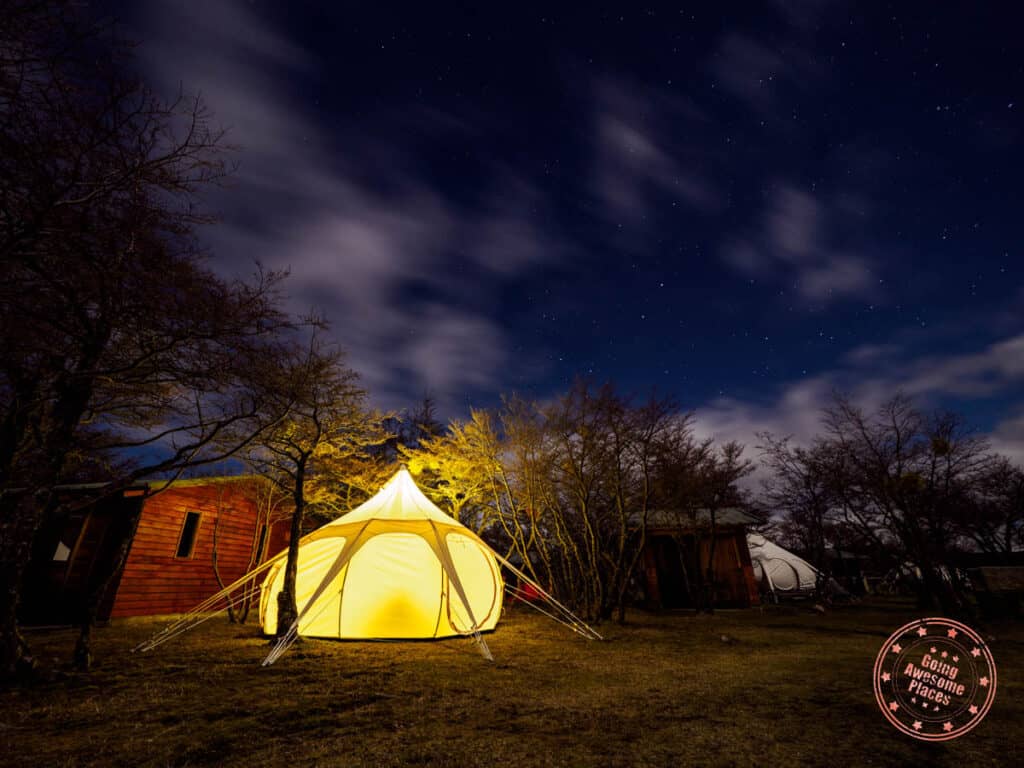
If you decide to travel with Chile Nativo, you’ll see that the standard accommodations they offer for any of their activities in Torres del Paine is at their Riverside Camp.
Outside of reading the marketing material prior to my trip to Patagonia, I honestly didn’t know what to expect as it’s a relatively new offering.
In this review of Riverside Camp, we will get you the answers you’re looking for and other details you didn’t know you needed to know, including what life at camp is like, what you’ll like, and things that can be improved.
Background of Riverside Camp
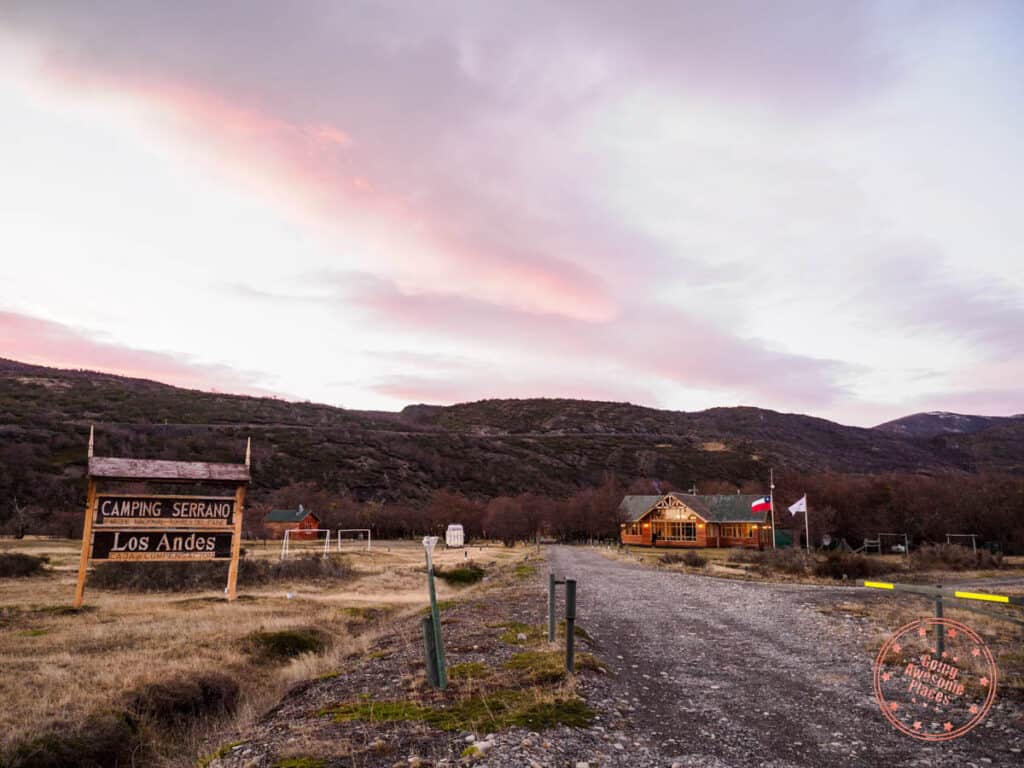
Let’s start off with a bit of information about the campsite itself. When you first arrive at Riverside Camp, you’ll notice the sign at the front says “Camping Serrano” which might cause a bit of confusion. Here’s why.
The campsite is owned by a company called Caja Los Andes which has properties, campsites, and community centers all over Chile.
Chile Nativo has a special arrangement with Caja Los Andes to run the restaurant in the dining lodge and has first dibs to claim specific block of dates for their 10 lotus tents.
For all intents and purposes, it’s primarily a Chile Nativo site but there are instances where you might see other customers at camp:
- Companies such as Swoop effectively use Chile Nativo to operate their tours on the ground so they can book dates for their tours which use up Chile Nativo’s own allocation of dates.
- Individuals can also book directly through Caja Los Andes (and any of their affiliates) since they offer traditional sites for tents and motorhomes. That said, it seems quite hard or impossible to do if you’re a foreigner – at least we haven’t had any luck figuring out their site.
- For dates that weren’t secured by Chile Nativo, other companies or individuals can book them through Caja Los Andes.
For clarity, all of the kitchen staff (host, kitchen, and waiter) are part of the Chile Nativo team, but housekeeping, janitors, maintenance, and administration is run by Caja Los Andes.
Special Discount with Chile Nativo

Chile Nativo was the main operator I used for my trip to Torres del Paine and they are the leaders in helping organize independent W and O treks but also do incredible guided experiences in the park.
We have your back! We’ve negotiated a special 5% promotion with Chile Nativo. This applies to existing packages that they offer but not add-ons & upgrades or fully customized tours.
How? Type in “Going Awesome Places” under “Referral discount”. Simple as that!
Where is Riverside Camp located?
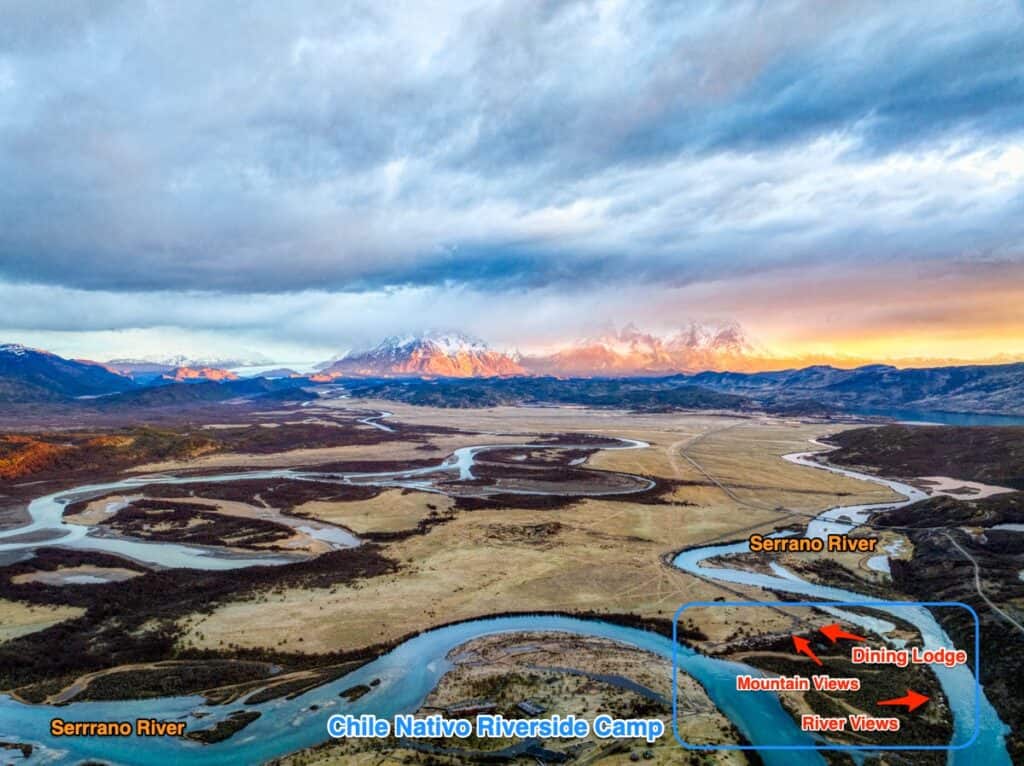
Riverside Camp is located near the Serrano Gate in the southern reaches of Torres del Paine. While it’ll look like it’s out of bounds, it is still within the national park. Anything northeast of the Serrano River (Rio Serrano) is part of Torres del Paine.
The campsite is part of Serrano Village which has a cluster of hotels, refugios, and lodges. That said, the nice part about this spot is that it’s quite isolated because of how the Serrano River bends so you won’t see any of the other properties.
If you’ve never been to Torres del Paine National Park in Patagonia, it’s hard to grasp where everything is in relation to one another. Below is an interactive map that covers our 10 day Patagonia itinerary of Torres del Paine where you’ll see Riverside Camp marked.
NOTE: Since Riverside Camp is within Torres del Paine National Park, drones are not allowed. The above photo was taken by flying the drone from outside of the national park.
Riverside Camp Layout
The campground is quite expansive and is divided into two distinct areas.
On one side, you have the Serrano River. There are 5 tents that face the bank of the river. This part of camp is also where you’ll find the drive-in sites and standard camping sites as well.
On the other side, near the entrance of Riverside Camp, are 5 more tents. This part of camp is more exposed and faces the Paine Massif. This is also where you’ll find the dining lodge.
There is some distance from the tents that are closer to the river than the side that faces the mountains. The trade off is that the mountain facing tents are more exposed so it can get windier whereas the ones by Serrano River are more protected. There are also fewer washrooms on the mountain side.
TIP: Request the tents that have the mountain view. You’ll love being able to walk out of the tent and watch the sunrise. Being closer to the dining lodge is also much more convenient.
What makes Riverside Camp great

Here’s what you’ll love about Chile Nativo’s Riverside Camp:
- You have a home base – Having a place to come back to every day makes a big difference, being able to keep your gear organized and to have a place to relax after a day of exploring.
- Tents are spacious and comfy – We’re not talking about regular tents here. The lotus tents have queen-sized inflatable mattresses and enormous floor space to lay all of your things out.
- Get pampered with delicious food – We cannot say enough about how amazing the food is here. The dining lodge serves local and delicious meals. You definitely won’t leave hungry or thirsty.
- Ridiculous views of the mountains – Right in front of the campsite is a picture perfect view of Paine Massif. You’ll see the best sunrises and sunsets from here.
- Serene and quiet – With the exception of wild horses that might come by, it is an area that’s away from the large crowds.
- It makes the trip more affordable – The reason why the luxury packages for Torres del Paine and Patagonia get so expensive are because of the hotels. It’s places like this that keep costs under control.
What is camp life like?

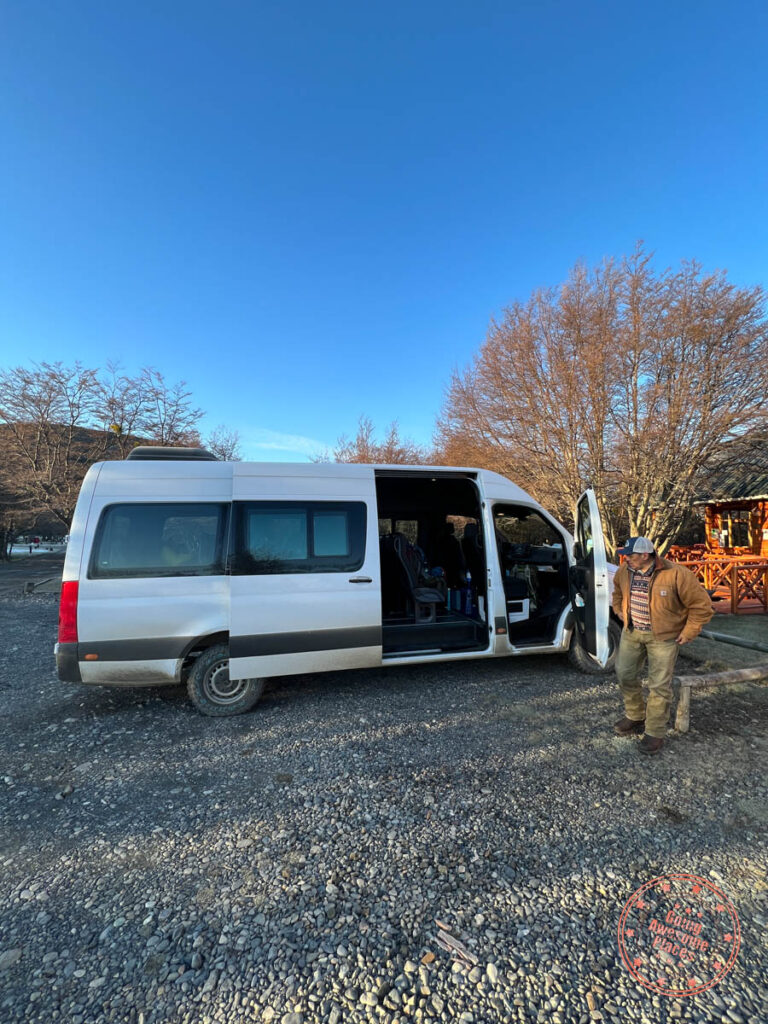
When you travel with Chile Nativo on packages such as their Multisport, W Trek Plus, and Photo Safari, your base of options will be Riverside Camp.
While there are many tents close together, you never feel like you’re too close to your neighbour. The guests staying here are normally quite quiet around the tents which makes it feel isolated.
All that said, most of the time, you won’t be using your tent other than for sleeping or organizing your gear.
The center of action is the dining hall. This is where it’s the easiest to charge your batteries, the most comfortable for lounging and socializing, where the lights are on at night, and of course, where the food and drinks are.
Here’s a breakdown of the day-in-the-life at Riverside Camp.
Morning routine
In the morning, after waking up, changing, and using the bathroom, you’ll head to the dining lodge for breakfast. Breakfast is usually quite brisk because from the time the dining lodge opens to when departure is, you’ll typically only have an hour.
After you finish breakfast, you’ll want to use the bathroom to brush up and/or shower.
You’ll then grab your gear from your tent and meets back at the dining lodge. From there, you’ll board your van.
TIP: We recommend that you put on sunscreen in the morning because you’ll hit the ground running and you’ll most likely forget.
Excursions during the day
Every day is different depending on your itinerary. We do a detailed description of how the Chile Nativo Multisport itinerary is like in our 10 day Patagonia itinerary.
Late afternoon routine
After you day of excursions, your van will drop off individuals first at the mountain-facing tents, followed by the river-facing tents. Before everyone splits off, your guide will pick a time for the briefing. As a group, you’ll decide whether you’re okay with that or need to push it to later to give yourselves more time.
Back at your tent, you’ll unload your gear and change into more comfortable clothes. This is pretty much the only alone time you’ll have in the day so you can spend it however you’d like. In some cases you’ll have an hour or more, and other times, just 30 minutes.
This is also the best time to use the showers, get your pack re-organized, and take photos because the lighting is great.
You can also head over to the dining lodge early as it’ll be open and power is on. You can also get the drinking started ahead of everyone else.
In most cases, you’ll find that once you get to the dining lodge, you probably won’t be leaving until after dinner.
Evening routine
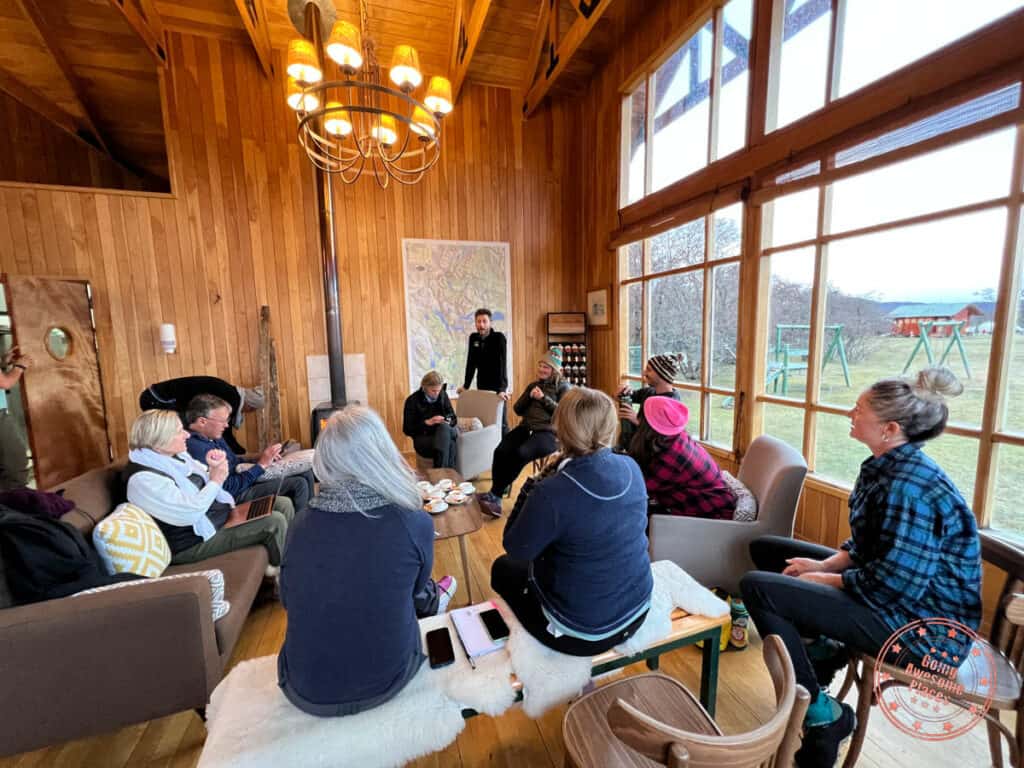
The evening starts with the briefing and naturally leads into dinner.
Standing in front of the giant map of Torres del Paine, your guide will essentially walk you through what you’ll be doing the next day.
As the group listens and asks questions, the dining lodge host brings out a variety of snacks and drinks.
Beyond covering the logistics, these sessions are great for learning the background of what you’ll be seeing or doing.
Another important bit of information you’ll get is the breakfast and departure times which you’ll want to write down.
There’s usually a lot of great conversation at this point but once the kitchen is ready with dinner, the group will be asked to get seated at the tables.
For dinner, there aren’t any fixed seating arrangements so you’ll be free to pick any spot you like. Drinks are followed by salad, the main course, and finally dessert.
Once dinner is done, people will slowly start filing out to get ready for bed. Others will stay longer to continue charging their devices, continue chatting, use their computers, or hang out in the lounge space.
You’ll be able to stay for as long as the dining lodge host is there but they typically close up at 11PM.
TORRES DEL PAINE TRAVEL GUIDE
Looking for an all-encompassing guide that covers travelling Torres del Paine in Patagonia? Make sure you queue this up next as you continue your trip planning.
Lotus tent

Riverside Camp uses Lotus Belle Deluxe Tents placed on a raised wooden platform. These are canvas tents that have a center pole, PVC windows with canvas roll down blinds, and large roof vents.
NOTE: You’ll see that my tent here doesn’t have a raised platform. We were a special group that required 2 additional tents beyond the 10 so mine was one of the ones that was added adhoc. I did not notice that the floor was colder or bumpier because it was in direct content with the ground.
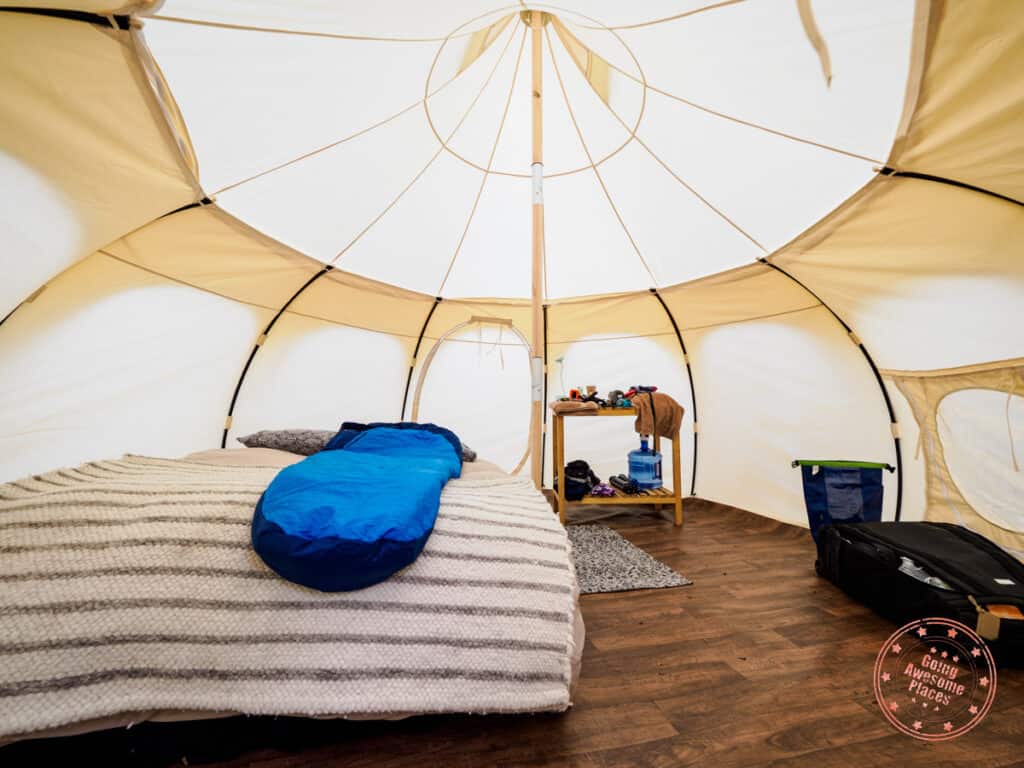
Inside, the tent is equipped with a queen-sized inflatable mattress (or configured with two twins) with fresh sheets, blanket, and pillows. Hotel quality linens are used so they are quite comfortable. Minus the sleeping bag, these are the normal beddings provided all year round.
When the weather is colder, they also have down-filled comforters, additional wool cover, and fleece blankets that are used to line the mattress.
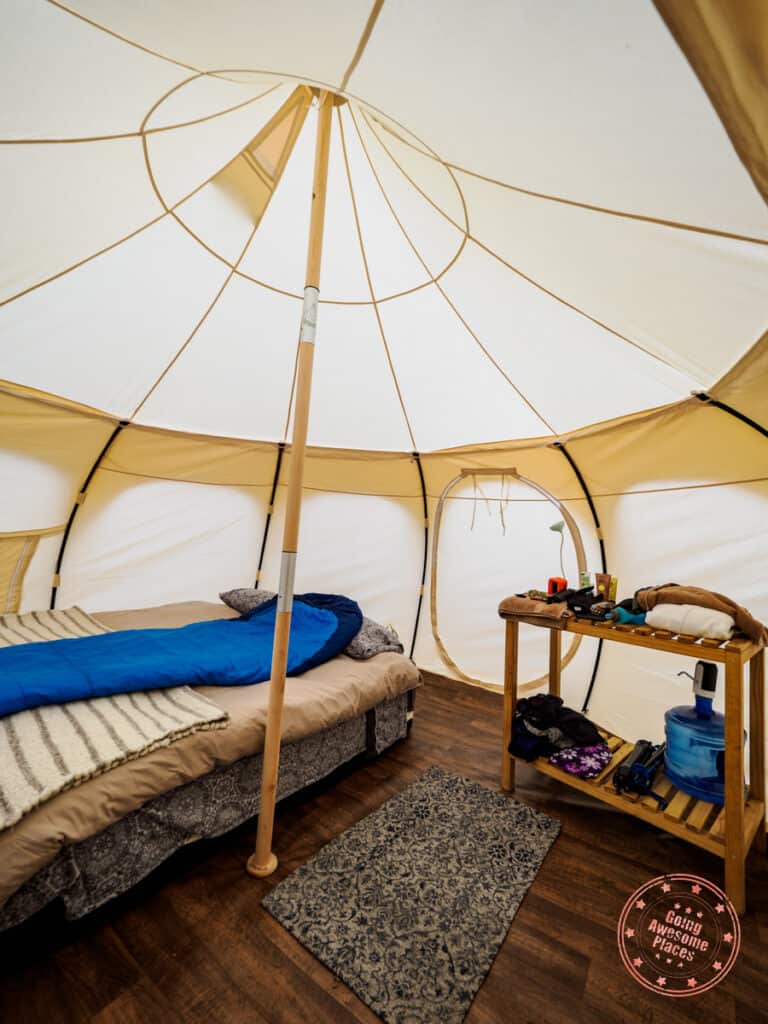

Next to the bed is a make-shift night stand that has a rechargeable lamp above and below is a 5 gallon water jug with a dispenser. Each guest is also provided with a robe and both bath and face towels.
On the ground is a faux-wood vinyl flooring makes it easy to clean and walk on. There’s also a bathroom mat next to the bed which is a nice touch.
While the tent has two entrances, one is locked so there is only one way in and out. The main entrance can’t be locked but you can ask the staff for a lock and key if you feel like you want that extra security.
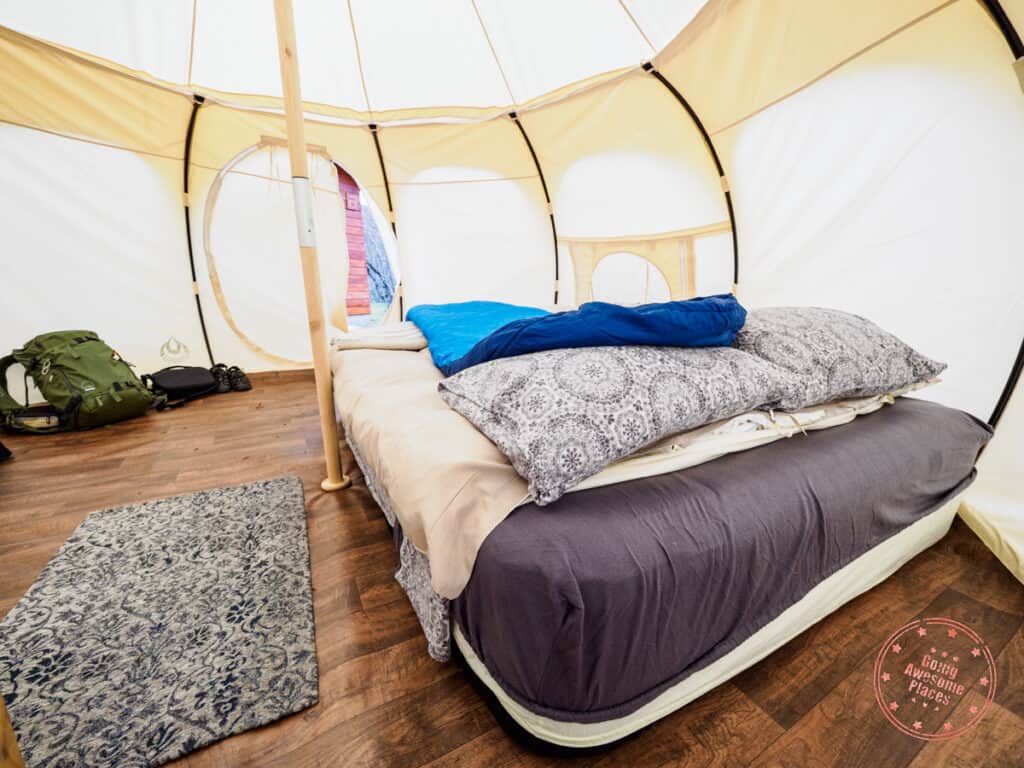
Overall, the tent is incredibly spacious, with a ton of space on the ground to lay your luggage. It is also tall enough to be able to walk around without any crouching.
The downside is that there are no electrical outlets inside the tent, no heater, and of course no bathroom. As you’d expect, the insulation is not great since it’s such a large space. Plus, the air mattress doesn’t help in that regard.
How is the sound isolation? As we mentioned earlier, it’s pretty hard to hear people in neighbouring tents but you will be able to hear outdoor noise throughout the night including birds and horses that might be nearby.
Is the tent safe? The honest truth is that it is incredibly safe in Torres del Paine. You should feel very comfortable in leaving your luggage in the tent unlocked. Also, housekeeping does not come in daily unless you request it.
TIP: On cold days, ask for a sleeping bag and fleece lining for the bed. If you need more warmth, they also have hot water bottles which will make a big difference. Also, make sure to pack thermal bottoms and tops.
Shelter
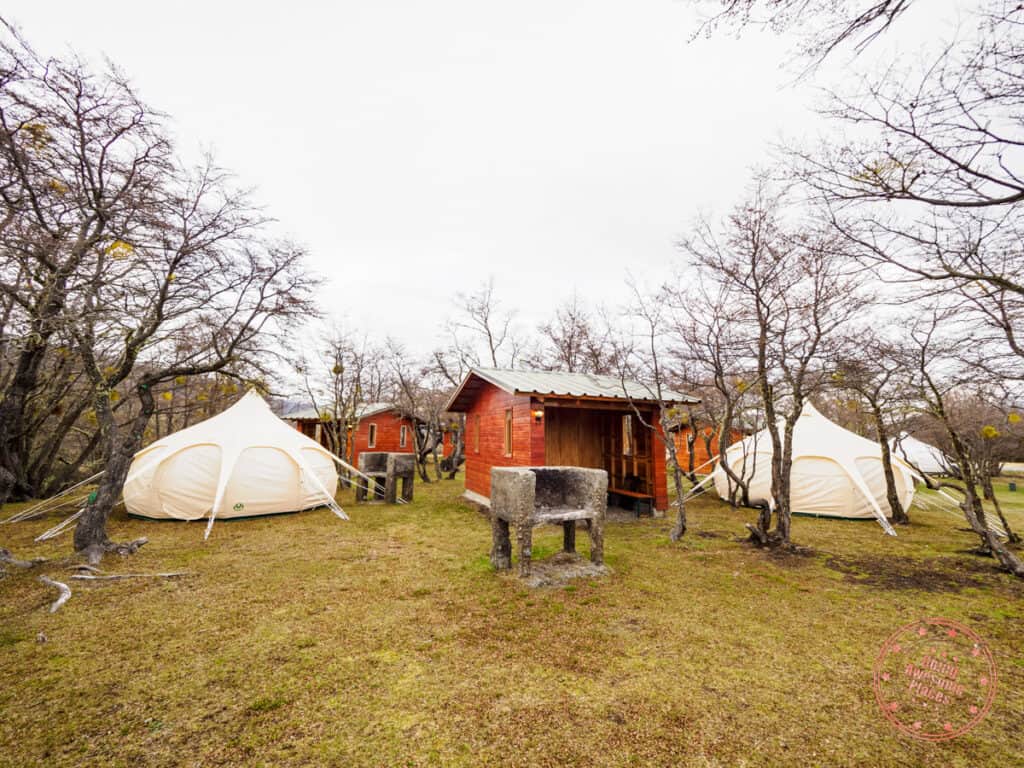
Beside each tent is an open-air shelter. It’s not clear whether they’re assigned but it’s pretty easy to tell which one is yours by its proximity to you.
These shelters were built when the space was used primarily for traditional camping so they aren’t the most relevant for those staying in a lotus tent since you have tons of space inside.
That said, the shelters have a bench and table so if you prefer to hang out outdoors or just want some time to yourself, to say, read a book, this is a great hideaway.

The most important feature of these shelters is the fact that they have a single electrical outlet. This is the closest outlet to your tent and is on for the entirety that the generator is running. The only thing to keep in mind that this is outdoors and exposed to the elements.
Washrooms
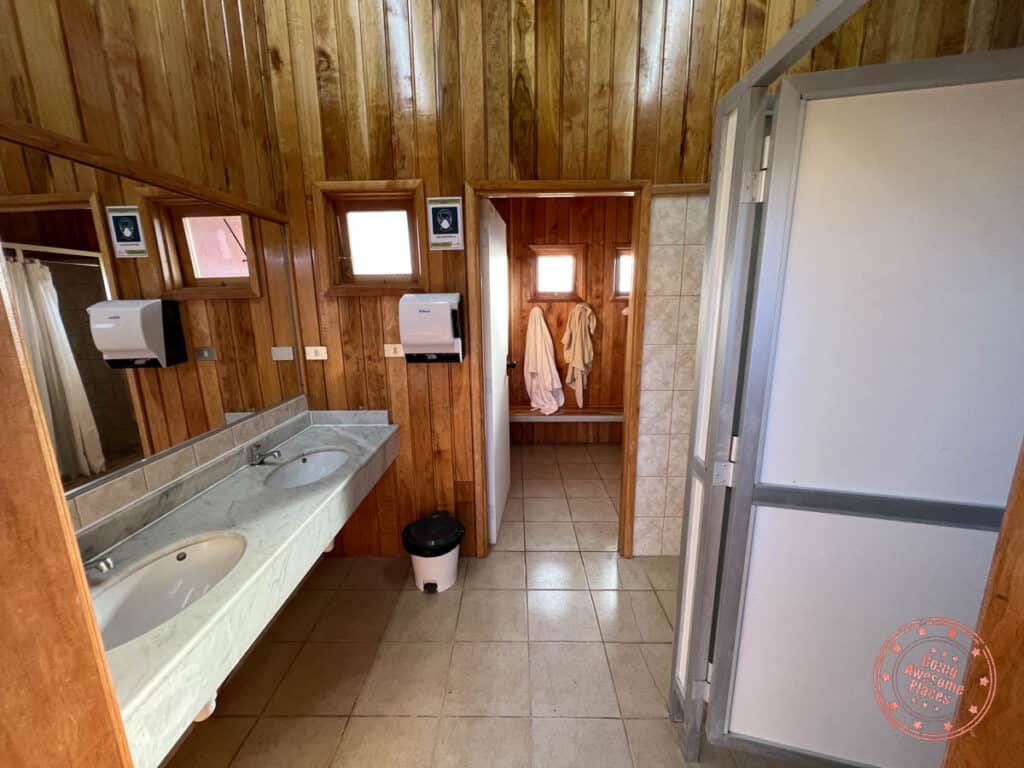
There are 9 separate washrooms scattered throughout Riverside Camp, each with separate sides for men and women.
Within each side, there are two toilets (plus urinal for men), two sinks, and two showers. The shower is in its own room with a bench and hooks.
Flushing, lights, hot water, and outlets only work when the electricity is running.
From what I could gather, there is only one bathroom for the tents facing the mountain but there are many more towards the river.
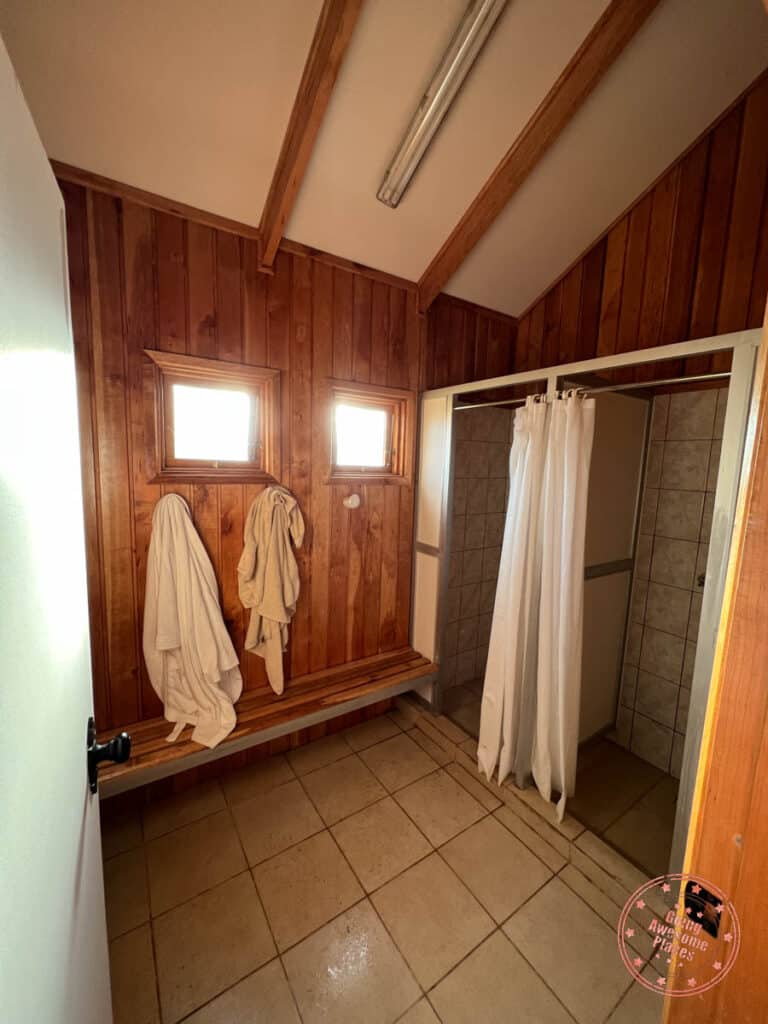

The shower situation can be a bit awkward as they don’t have individual changing areas so you may want to stagger the timing. Water pressure is decent but the consistency of hot water can fluctuate.
TIP: The quietest time to use the showers is late in the evening (11PM-midnight). You can also walk to another washroom building at camp as some are busier than others.
Dining Lodge

The dining lodge is positioned near the entrance of campsite and will be your favourite part of your stay.
With high-beam ceilings, large windows, and open spaces, this is the place to come to relax, gather around the fireplace, share stories with fellow guests, and of course, eat fabulous meals.

On one side of the lodge is a large couch, giant map of Torres del Paine, and a fireplace. This is where the daily briefing is conducted by your guide. There is also a fireplace on the other side.
The central part of the dining hall is the open grill and serving table.
For dining, there are individual square tables with wooden chairs. Depending on how large the group is, tables will be put together so your crew can eat together.
There are several outlets scattered throughout the lodge that are shared with all the guests. They also provide one power bar so there should be plenty of places to charge.
Finally, the lodge has bathrooms for men and women.
TIP: If your shoes or any other items get wet, you can place them by the fireplace to dry up.
TIP 2: If you run out of outlets, there’s also an electrical outlet in the hallway leading to the bathrooms.
Meals
The food at the Chile Nativo Riverside Camp will be surely one of the highlights of your trip to Torres del Paine. With such a small staff and being as remote as it is, you’ll be amazed the culinary surprises they’re able to create!
Breakfast
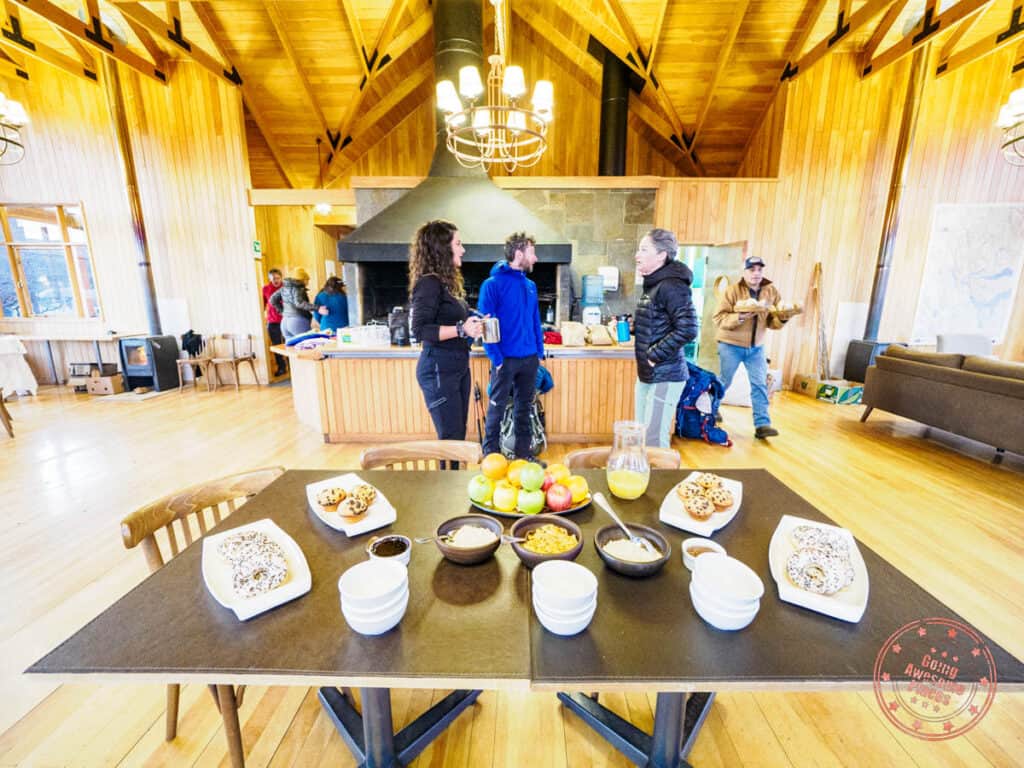
The buffet breakfast is laid out at the start of every morning. The spread varies slightly every day but you can expect the typical Chilean mix of sliced cheese, salami, bread, yogurt, cereal, granola, oatmeal, fruits, and various pastries.
They also make scrambled eggs for the group to share. A great way to have these eggs is to make a sandwich out of it with the bread, cheese, and salami.
For drinks they have hot water, orange juice, tea, milk, and coffee.
It’s a simple breakfast but you’ll find that mornings are a bit of a rush to get out the door.
TIP: There’s usually a water jug here that you can use to fill up your bottles and hydration bladders. Remember to do this before you head out for the day. If a jug isn’t there, it’s quite safe to use the tap water in the kitchen. Don’t forget that there’s also water inside your tent.
Lunch

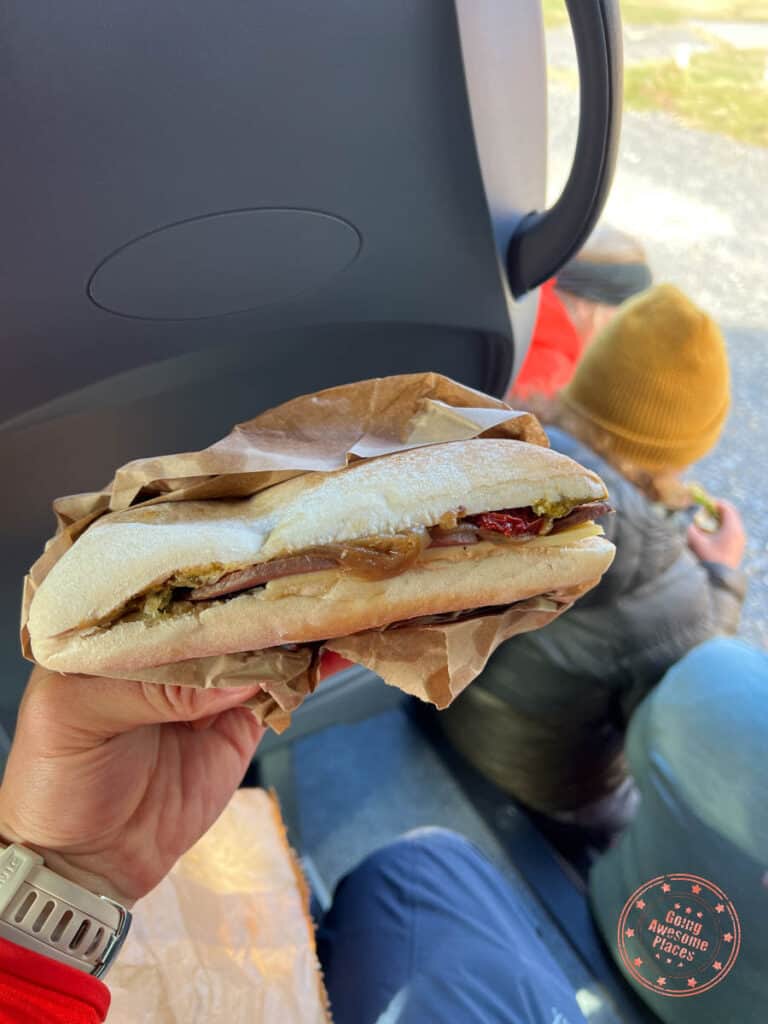
With how the itinerary is set up, you never come back to camp for lunch. This is why at breakfast, brown bags are laid out in the dining hall. Everyone grabs one to pack into their backpack.
The bagged lunch consist of:
- Sandwich – These are simple yet complex sandwiches. No two days were different and were always packed with great flavors.
- Protein bar
- Pouch of trail mix
- Mini chocolate bar
The guides will also have both a hot water and coffee thermoses and plastic cups. They will offer this to those that are interested at lunch.
Briefing snack



During the briefing, the kitchen will make the most appetizing snacks for the group. They usually consist of a mix of finger foods, and sopaipilla with salsa. On some days, you might also get a bonus individual ramekin of scallops or crab.

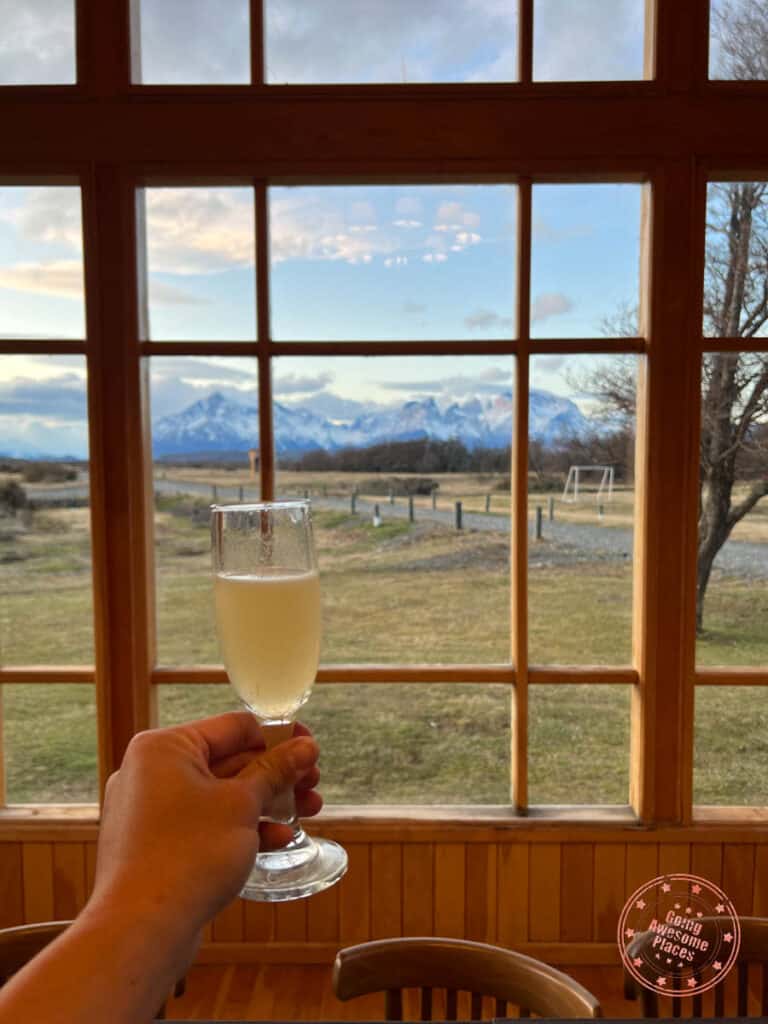
For drinks, they’ll take orders of freshly made pisco sour, wine, or beer.
The steady flow of food and drinks always makes the briefing a fun part of the evening.
Dinner
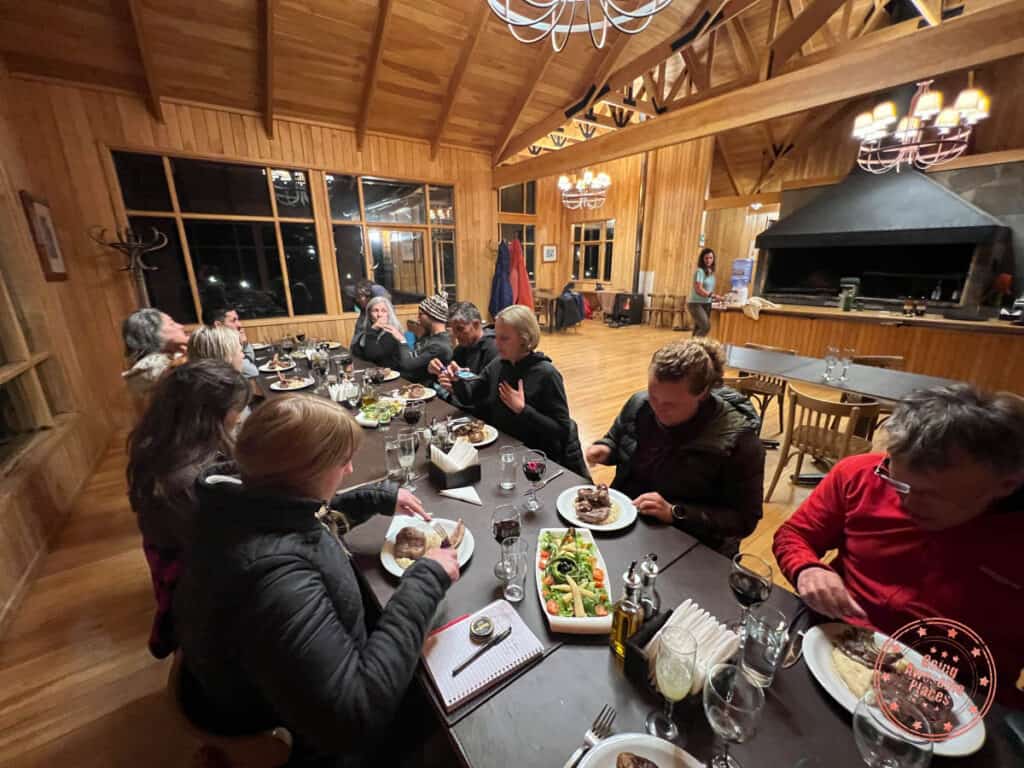
The kitchen staff is quite small with just a host, waiter, and chef, but the food that comes out of it is always a delight. The Chilean dishes prepared with local ingredients are made with care and always a great surprise.
Dinner starts with salad that’s shared with everyone, followed by the main, and then dessert with coffee or tea.
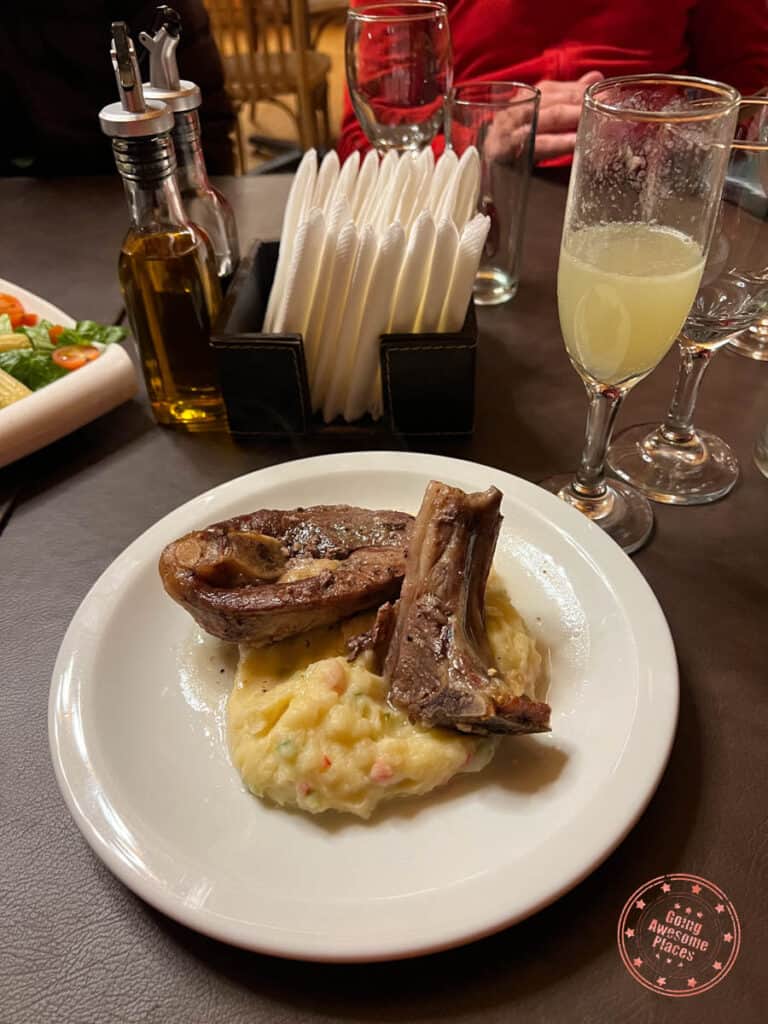
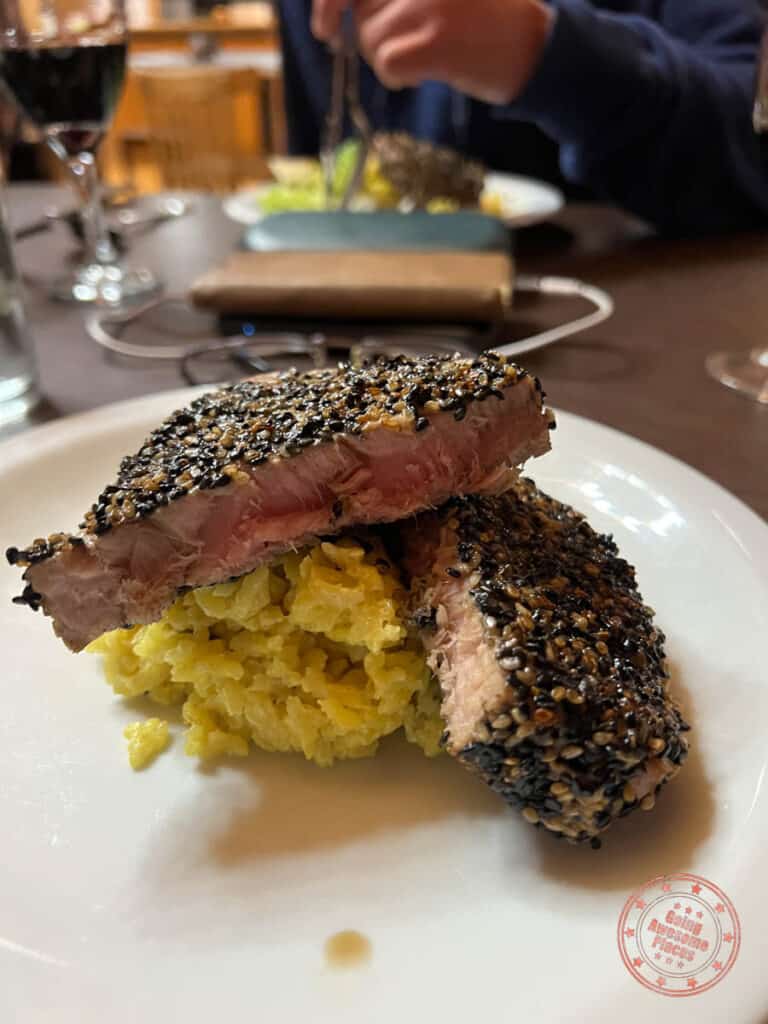

Here are examples of mains that we had:
- Chilean fish stew (Caldillo de Congrio)
- Lamb
- Grilled Tuna
- Special BBQ – On one of your nights, you’ll have a traditional Patagonian BBQ that’s cooked right in front of you in the dining lodge. There’s an all-you-can-eat selection of steak, chicken, lamb, sausages, grilled vegetables, and salad.
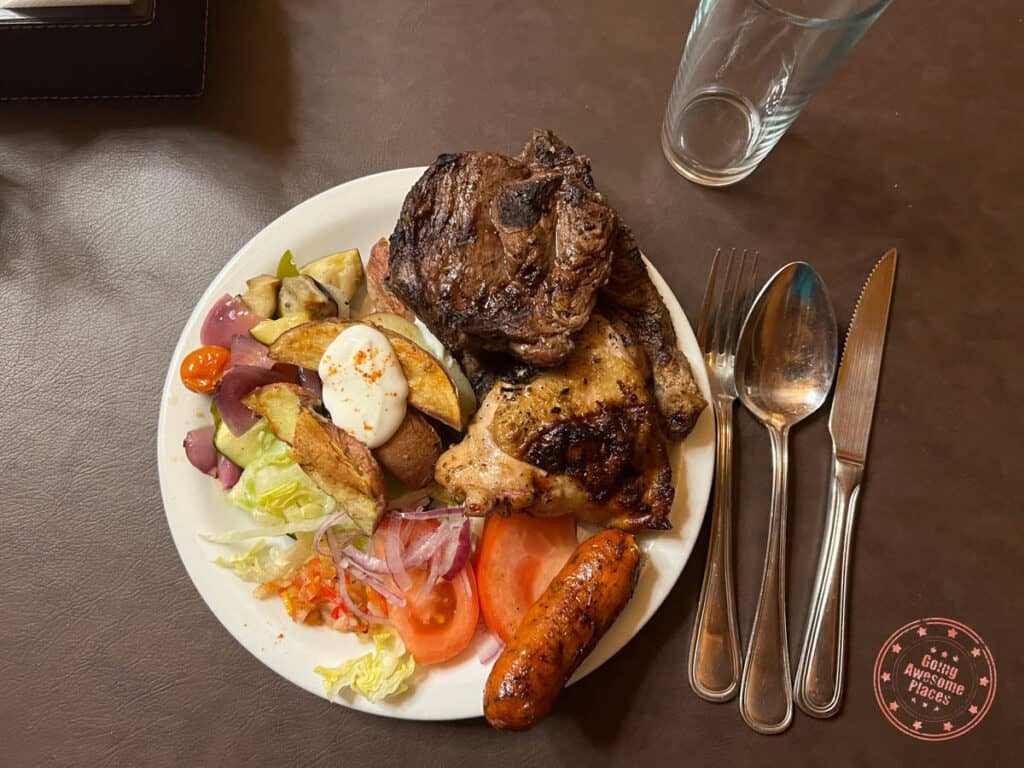
Beverage wise, they will have beer and wine on hand but they won’t have a wide selection. This is effectively an open bar so you can drink as much as you want. They also have water and juices available.
Let’s just say that we drank many bottles of carmenere, pinot noir, chardonnay, and others I’m forgetting about during our 5 nights.


If I was nitpicking, dessert was the least impressive. Here are a few examples of what we had:
- Dulce de leche ice cream
- Grilled pineapple
- Creme brûlée
- Raspberry pavlova
Dietary restrictions
If you have any type of dietary restrictions, they’ll have that taken care for you. Whether it be breakfast, lunch, snack, or dinner, they’ll always have an alternative prepared.
Save When Booking With Chile Nativo
There aren’t a lot of big deals to be had when planning a Patagonia trip but we’ve been able to secure a 5% promotion with Chile Nativo. This applies to existing packages that they offer but not add-ons & upgrades or fully customized tours.
How to get the discount? Type in “Going Awesome Places” under “Referral discount”. Simple as that!
Electricity
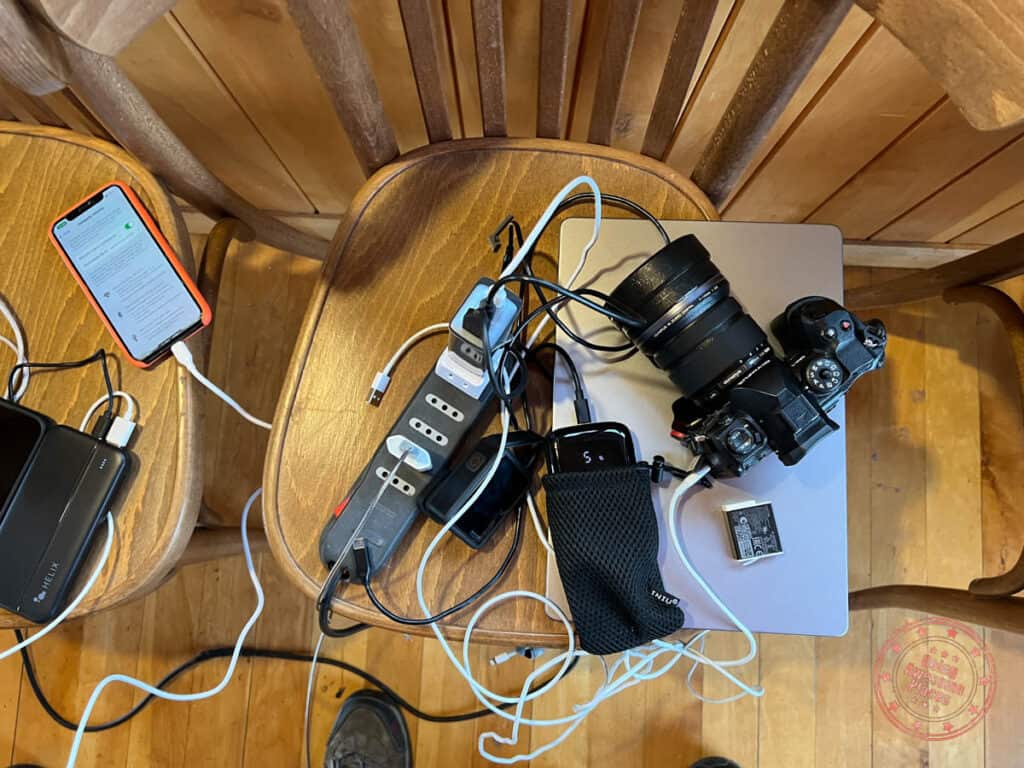
As a campsite with non-fixed structures, it’s understandable that there are no outlets in the tent. Also, since they run off of a diesel generator, they only run at specific hours to minimize their impact on the environment.
I can understand this being one of your main hesitations about staying at Riverside Camp. It certainly was for me. Let me put your mind to rest by explaining how it works and how I was able to charge all of my devices.
Officially, the diesel generators for electricity only run in the morning from 8-9AM and 8-12PM. This impacts the following things:
- Flushing the toilet
- Getting hot water
- Charging devices
- Light in the dining lodge
In reality, the times themselves are a bit dynamic:
- Morning – The dining lodge opens according to the start times of the groups so it isn’t always exactly 8AM. Sometimes the power doesn’t turn on right away at breakfast and comes on a little late or sometimes it’ll be on by the time you arrive.
- Evening – Power normally comes on when you arrive back at camp so in reality, you get more hours of electricity than they say. You can stay and charge in the dining lodge typically until 11PM where they will then kick you out and lock the doors. You could leave your gadgets charging in the dining lodge overnight but you won’t have access to them after the doors close. Afterwards, you’ll have to continue charging in your shelter. They do accurately shut down the generator at midnight.
This means that you have to be strategic with how you charge your devices if you want to always be topped up. Expect to do most of your charging in the evening.
Best strategy for charging at Riverside Camp
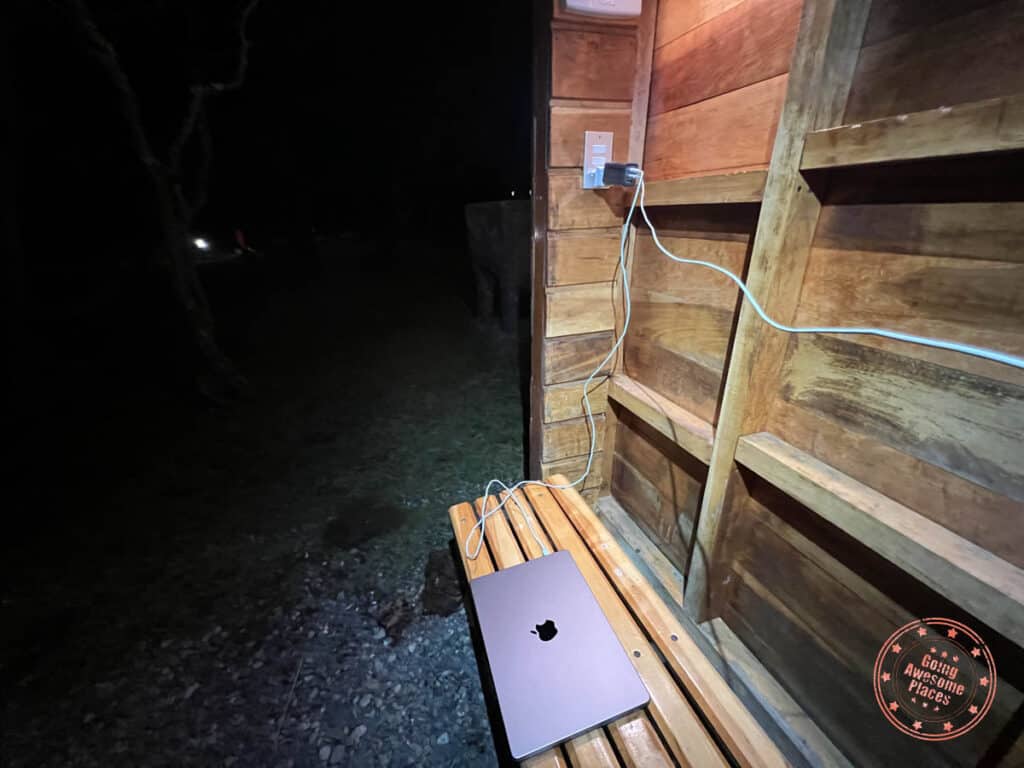
Here are a few things that I learned to do in order to make sure all of my batteries were topped up. As a content creator, this included the phone, camera batteries (2), GoPro batteries (2), power bank, microphones, and laptop that you’ll see in our Patagonia packing list.
- Charge in the dining lodge – The most comfortable place to charge will be in the dining lodge in the afternoon and evening since you’ll be spending most of your time here. For instance, if you’re charging your phone, you’ll at least be able to check it once in awhile.
- Bring an adapter with multiple outputs – There are a finite number of outlets so you need to be able to charge all of your devices from one plug. Use an adapter like this one with a combination of USB-C and regular USB outlets.
- Dual battery chargers are key – Having dual chargers for your camera batteries and GoPro batteries that can charge them simultaneously will save you a lot of time.
- Utilize the shelter outlet – The dining lodge closes at around 11PM, after which, you’ll still have an hour left of electricity. Continue charging by using the single outlet in the shelter.
- Use your laptop like a powerbank – Your laptop can charge devices as well. A smart way to use this is to charge any remaining devices in the tent after the generators turn off.
- Squeeze in more charging in the morning – Breakfast is always quite frantic but once the dining lodge opens and power is restored, you can charge your devices.
- Vans can charge too – If you’re desperate, the van has a USB outlet so it’s always handy to have those cables with you.
By employing the above techniques, you’ll be able to have your batteries topped up. Granted, it’s a bit more of a concentrated effort but once you get into a routine, it isn’t too hard.
REMINDER: Chile uses the Type F plug (Chile and Italy) but you will be able to use the standard European Type C plugs as well.
Internet connectivity

If you’ve come to Patagonia to look for high speed connectivity, I’m sad to say that Riverside Camp isn’t going to be for you.
While there isn’t any wifi, there is decent cellular connectivity if you have an Entel SIM or you are roaming on their towers.
Most of the time, you’ll see 3/4 or 4/4 bars of 3G signal which is good enough for most things you’ll want to do on your phone minus streaming.
That said, I was able to easily upload Instagram video stories with this connection speed so I was more than happy with Entel.
The reason why Entel is the only carrier to use if you’re going to Patagonia is because they have superior coverage in the rural areas of Chile.
TIP: Make sure to pick up an Entel SIM card in Santiago, Puerto Natales, or Punta Arenas along your way to Torres del Paine. If you’re not able to, ask Chile Nativo and they might be able to figure out a solution for you.
Best places to photograph Torres del Paine from camp

The beauty of staying at Riverside Camp is that you don’t need an eagle eye to find the perfect composition of Torres del Paine National Park. It’s literally right there in front of you.
Here are a few ideas of locations that you can try:
- Photographing the mountains from inside the dining lodge’s large main windows.
- Walk across the gravel road from the mountain-view tents and you’ll be in a large meadow with direct views of Paine Massif.
- If you walk along the main road that leads to Riverside Camp, you’ll see the Serrano River to the right. Keep going until you see where it bends a little. This is a great spot to get the river in the foreground and the mountain behind.
TIP: Don’t be afraid to zoom in to get close to those jagged mountain ridges. Also, if there are clouds, this is a great location to film timelapses.
What could be improved at Riverside Camp
There are definitely several areas where Riverside Camp could be improved.
- Lighting – The small LED lamp is nice but it would be nice to have a brighter one with wider output. That’s why we recommend bringing your own headlamp for camping.
- Mattress – With how permanent the tents are, real mattresses would be a great upgrade. Some guests had their inflatables mattress slowly deflate over time, requiring a re-inflation. Inflatable mattresses are also not great for insulation, meaning that none of the body heat on your back is retained.
- Electricity – It would be amazing to something as simple an extension cord to run power straight into the tent. That would allow you to more comfortably charge your gear in your tent instead of doing it all in the dining lodge.
- Clothesline and hangers – Inside the tent, you’ll notice that there are no hanging points or built-in clotheslines which means you can’t hang anything up if you decided to wash your clothes. It would be great to have this inside the tent to allow things to dry during the day. There were a few times where I would have loved to have washed my muddy pants and gaiters but there wasn’t a good place to dry them out.
- Garbage bins – Notice how there are no garbage bins in the tent. That would definitely be helpful.
- Dessert – As we mentioned earlier, the dessert isn’t bad per say, but it wasn’t overly impressive either. We would love to see larger portions and more Chilean desserts such as kuchen, torta de mil hojas, and leche asada.
Final Thoughts

What makes Riverside Camp special is how easy it makes it for you to connect in Torres del Paine whether it be it’s remarkable landscape or the people that you’re traveling with. As part of our larger 1 month Chile itinerary, this was definitely one of the memorable accommodations we had all trip.
First you have your lotus tents where you’ll be instantly connected to the wild nature of Patagonia with the birds that make their calls, wild horses grazing in the field, and of course the incredible view of the mountain range, especially when those hues of pink, purple, red, and orange light up the sky.
The other part that makes a stay here memorable are the connections you make with your fellow travellers. From the dining lodge, you’ll make fast friends with your group, connecting on all of the shared experiences that you’ll have and conversations about your shared passion of travel.
Frequently Asked Questions
Torres del Paine can get cold at night. If the existing beddings aren’t warm enough, you can request additional layers which they do have available. We also recommend wearing additional layers such as thermals to stay warm at night.
Riverside Camp isn’t fenced and so wildlife can come in and through the area. In most cases these are wild horses. Pumas aren’t known to come to this area. There are no safety concerns.
In cold weather, there are no issues with mosquitoes or any other type of bug. In the summer, wind and cool temperatures keep mosquitoes away but if there’s a spell of hot and wet weather, you may see them but overall it’s not an issue.
The campsite is very safe as there is always staff on hand. If you want extra security for your tent, you can request a lock and key.
No, the campsite is inside Torres del Paine National Park where drones are explicitly not allowed.
We wouldn’t classify this as glamping in the traditional sense because the tents aren’t heated, there aren’t any bathroom facilities, and they aren’t luxuriously furnished. It’s a tad below glamping. It has the all-inclusive dining but the tents aren’t quite at that luxury level.
Yes, if you use “Going Awesome Places” under “Referral discount” in the booking for, save 5% on their package tours.
What you should read next
Leave a Reply